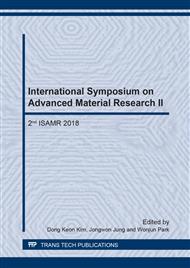[1]
L. F. Borisenko, L. M. Delitsyn and A. S. Vlasov, Perspectives of using ash from coal thermal power plants. ZAO Geoinformmark, Moscow, (2001).
Google Scholar
[2]
Yu. K. Tselikovsky, Experience of industrial use of ash and slag wastes of thermal power plants. New in the Russian Power Industry. Energoizdat, 2 (2000) 22-31.
Google Scholar
[3]
Yu. K. Tselikovsky, Some problems of using ash and slag wastes of thermal power plants in Russia. Energetik, 7 (1998) 29-34.
Google Scholar
[4]
L. Ya. Kizil'shtein, I. V. Dubov, A. P. Shpitsgauz, and S. G. Parada, Components of ash and slag of TPP, Energoatomizdat, Moscow, (1995).
Google Scholar
[5]
T. Rahele, M. Govindan, Clinical Waste Management: A Review on Important Factors in Clinical Waste Generation Rate. Int. J. Sci. Tech. 3(3) (2013) 194-200.
Google Scholar
[6]
H. Taghipour, and M. Mosaferi, Characterization of medical waste from hospitals in Tabriz, Iran. Sci. Total Envir. 407(5) (2009) 1527-1535.
DOI: 10.1016/j.scitotenv.2008.11.032
Google Scholar
[7]
Y. W. Cheng, F. C. Sung, Y. Yang, Y. H. Lo, Y. T. Chung, and K. C. Li, Medical waste production at hospitals and associated factors. Waste Manag. 29(1) (2009) 440–444.
DOI: 10.1016/j.wasman.2008.01.014
Google Scholar
[8]
O. Dasimah, N. N. Siti, A. Subramaniam and L. Karuppannan, Clinical Waste Management in District Hospitals of Tumpat, Batu Pahat and Taiping. Soc. Behav. Sci. 68 (2012) 134-145.
DOI: 10.1016/j.sbspro.2012.12.213
Google Scholar
[9]
M. S. Hossain, A. Santhanam, N. N. A. Nik, A. K. Omar, Clinical solid waste management practices and its impact on human health and environment – A review. Waste Manag, 31(4) (2011) 754-766.
DOI: 10.1016/j.wasman.2010.11.008
Google Scholar
[10]
A. Mehrdad, V. Mahmood, K. Gholamhosein, Results of a hospital waste survey in private hospitals in Fars province, Iran. Waste Manag. 24(4) (2004) 347-352.
DOI: 10.1016/j.wasman.2003.09.008
Google Scholar
[11]
S. R. Shaidatul, B. I. Mohd. Clinical waste handling and obstacles in Malaysia. J. Urb. Envir. Eng. (JUEE), 4(2) (2010) 47-54.
Google Scholar
[12]
R. D. Li, Y. F. Nie, R. Bernhard, L. Wang. Options for Healthcare Waste Management and Treatment in China. Chinese J. Proc. Eng. 6(2) (2006) 261-266.
Google Scholar
[13]
F. Ali, F. Masoud, and J. M. Mohammd, Incineration or Autoclave? A Comparative Study in Isfahan Hospitals Waste Management System. Mater. Sociomed. 25(1) (2010) 48-51.
DOI: 10.5455/msm.2013.25.48-51
Google Scholar
[14]
SanPiN 2.1.7.2790-10 Sanitary and Epidemiological requirements for the management of clinical waste, [online] Available at: http://www.sisterflo.ru/sanpins/SP2790-10.php, accessed on Dec.12, (2017).
Google Scholar
[15]
HTM 07-01 Safe management of healthcare waste, [online] Available at: http://www.dhsspsni.gov.uk , accessed on December 12, (2017).
Google Scholar
[16]
O. V. Myronenko, A. U. Lomtev, E. M. Ozerova, A. V. Pankin, L. A. Soprun. Application of GIS technology to solve the problem of medical waste management classes B and C in the example of the city of St. Petersburg [online] Available at: http://www.poliklin.ru/imagearticle/201306/60-66.pdf , accessed on December 12, (2017).
Google Scholar
[17]
X. Zhao, Q. Y. Wang, Y. J. Liu, Review on the Properties of Bricks Prepared with Recycled Waste Materials - Postearthquake Waste Consideration. Adv. Mater. Res. 661 (2013) 108-111.
DOI: 10.4028/www.scientific.net/amr.661.108
Google Scholar
[18]
C. Martinez Garcia, S. Bueno, and M. Dondi, Production of Ceramic Materials Using only Waste as Raw Materials. Key Eng. Mater. 663 (2015) 62-71.
DOI: 10.4028/www.scientific.net/kem.663.62
Google Scholar
[19]
J. Brito, R. Silva, Use of Waste Materials in the Production of Concrete. Key Eng. Mater. 634 (2014) 85-96.
Google Scholar
[20]
D. Z. Chen, C. J. Geng, W. S. Zhou, Evaluation Indexes Systems for Assessing Road Construction with Recycled Waste Materials to Achieve Better Environmental Impact. Adv. Mater. Res. 250-253 (2011) 1001-1006.
DOI: 10.4028/www.scientific.net/amr.250-253.1001
Google Scholar
[21]
M. Seslija, N. Radovic, V. Vatin, Construction of Road Embankment with Waste Materials. Appl. Mech. Mater. 725-726 (2015) 596-601.
DOI: 10.4028/www.scientific.net/amm.725-726.596
Google Scholar
[22]
E. Cokca, Use of class C Fly Ashes for the Stabiliyation of an Expansive Soil, J. Geotech. Geoenvir, Eng, 127(7) (2001) 568-573.
DOI: 10.1061/(asce)1090-0241(2001)127:7(568)
Google Scholar
[23]
C. R. Kaniraj, V. P. Gayathri, and Consolidation Characteristics of Compacted Fly Ash, J. Energ. Eng. 130(1) (2004) 18-43.
DOI: 10.1061/(asce)0733-9402(2004)130:1(18)
Google Scholar
[24]
M. Basu, M. Pande, P. B. S. Bhadoria, S. C. Mahapatra, Potential fly-ash utilization in agriculture: A global review (2009) Progress in Natural Science, 19(10), pp.1173-1186.
DOI: 10.1016/j.pnsc.2008.12.006
Google Scholar
[25]
J. S. Singh, V. C. Pandey, Fly ash application in nutrient poor agriculture soils: Impact on methanotrophs population dynamics and paddy yields, Ecotoxic. Envir. Safety, 89, pp.43-51.
DOI: 10.1016/j.ecoenv.2012.11.011
Google Scholar
[26]
D. A. Golubev. Practical Guidance on waste management of health facilities [online] Available at: http://www.proothody.ru/articles/img/MR%203.1.6.001-2010.pdf , accessed on December 12, (2017).
Google Scholar


